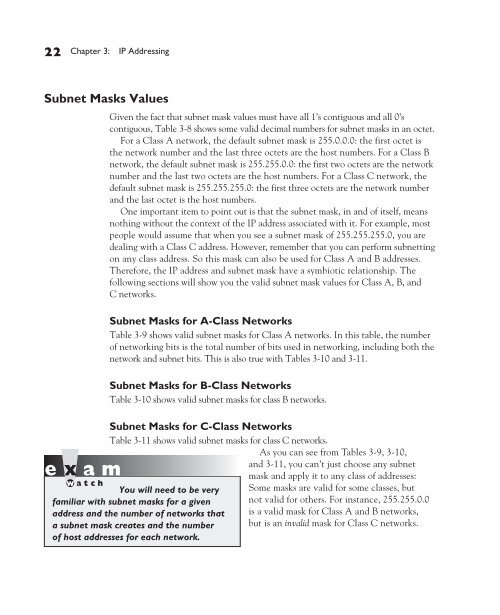ch03 IP Addressing.pdf - The Cisco Learning Network
ch03 IP Addressing.pdf - The Cisco Learning Network
ch03 IP Addressing.pdf - The Cisco Learning Network
You also want an ePaper? Increase the reach of your titles
YUMPU automatically turns print PDFs into web optimized ePapers that Google loves.
22 Chapter 3: <strong>IP</strong> <strong>Addressing</strong><br />
Subnet Masks Values<br />
Given the fact that subnet mask values must have all 1’s contiguous and all 0’s<br />
contiguous, Table 3-8 shows some valid decimal numbers for subnet masks in an octet.<br />
For a Class A network, the default subnet mask is 255.0.0.0: the first octet is<br />
the network number and the last three octets are the host numbers. For a Class B<br />
network, the default subnet mask is 255.255.0.0: the first two octets are the network<br />
number and the last two octets are the host numbers. For a Class C network, the<br />
default subnet mask is 255.255.255.0: the first three octets are the network number<br />
and the last octet is the host numbers.<br />
One important item to point out is that the subnet mask, in and of itself, means<br />
nothing without the context of the <strong>IP</strong> address associated with it. For example, most<br />
people would assume that when you see a subnet mask of 255.255.255.0, you are<br />
dealing with a Class C address. However, remember that you can perform subnetting<br />
on any class address. So this mask can also be used for Class A and B addresses.<br />
<strong>The</strong>refore, the <strong>IP</strong> address and subnet mask have a symbiotic relationship. <strong>The</strong><br />
following sections will show you the valid subnet mask values for Class A, B, and<br />
C networks.<br />
Subnet Masks for A-Class <strong>Network</strong>s<br />
Table 3-9 shows valid subnet masks for Class A networks. In this table, the number<br />
of networking bits is the total number of bits used in networking, including both the<br />
network and subnet bits. This is also true with Tables 3-10 and 3-11.<br />
Subnet Masks for B-Class <strong>Network</strong>s<br />
Table 3-10 shows valid subnet masks for class B networks.<br />
Subnet Masks for C-Class <strong>Network</strong>s<br />
Table 3-11 shows valid subnet masks for class C networks.<br />
As you can see from Tables 3-9, 3-10,<br />
and 3-11, you can’t just choose any subnet<br />
mask and apply it to any class of addresses:<br />
You will need to be very<br />
familiar with subnet masks for a given<br />
address and the number of networks that<br />
a subnet mask creates and the number<br />
of host addresses for each network.<br />
Some masks are valid for some classes, but<br />
not valid for others. For instance, 255.255.0.0<br />
is a valid mask for Class A and B networks,<br />
but is an invalid mask for Class C networks.

















